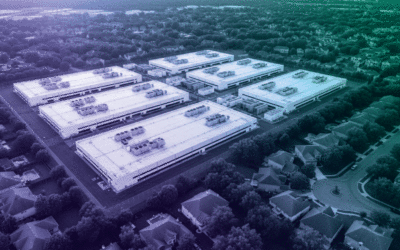By Josh Price, Capstone Energy Analyst
May 26, 2024 — The artificial intelligence-driven demand boom for data centers—and the requisite energy needed to power them—has dominated media coverage and earnings calls since the start of the year and recently took center stage in the Senate Energy & Natural Resources Committee. “Let me be clear: this load growth is the opportunity of a generation, and it’s ours to lose,” said Committee Chairman Joe Manchin (D-WV) in his opening remarks during a hearing on May 21st, calling for permitting reforms to facilitate energy infrastructure buildout to meet growing power demand.
It’s no surprise that the thrust of the Senate hearing was on the need for permitting reform to deal with resurgent load growth—something Sen. Manchin has long championed—however, we believe it reveals the limits of federal legislative action in an area that falls primarily under state and local jurisdiction. Absent significant reforms to the Federal Power Act, states will continue to retain authority over their power generation mix and retail electricity rates. That includes siting permits for new power plants, utility rates for large loads like data centers, and enacting policies that can accelerate or impede the deployment of new data centers.
However, this jurisdictional divide has not stopped federal policy fights—particularly on who foots the bill for the cost of transmission infrastructure and ensure new demand is met with “additional” clean power supply (primarily in a hydrogen production context)—from trickling down to state-level legislative and regulatory proceedings. These issues are emerging in both blue and red states, with recent developments in Maryland and Ohio serving as harbingers for upcoming policy debates on data center load growth.
We believe the growing focus among policymakers on 1) ensuring equitable cost-sharing for electric infrastructure investment to support new data centers and 2) whether new sources of power demand are supplied by new sources of clean power will increase demand for new behind-the-meter (BTM) generation at data centers.
Ultimately, we believe the growing focus among policymakers on 1) ensuring equitable cost-sharing for electric infrastructure investment to support new data centers and 2) whether new sources of power demand are supplied by new sources of clean power will increase demand for new behind-the-meter (BTM) generation at data centers. We expect blue states likely prioritize new, clean generation to meet load, and red states will likely be more ambivalent toward generation sources, creating opportunities for BTM generation like solar + storage, fuel cells, and combined heat and power (CHP) systems.
Some quick background on the federal cost allocation and carbon accounting debates currently playing out:
The Transmission Cost Allocation Debate: when determining who must pay for new transmission, conservative policymakers generally want new sources of supply (e.g., solar developers) or demand (e.g., ratepayers in progressive states with climate targets) to bear the brunt of costs as the primary drivers and beneficiaries of the infrastructure. Progressive policymakers generally want broader socialization of costs due to region-wide benefits of new infrastructure to all customers.
Hydrogen Carbon Accounting Debate: to qualify for the $3/kg incentive for hydrogen production under Section 45V of the Inflation Reduction Act (IRA), Treasury proposed an “incrementality” requirement for power procurement, which limits the supply of power for green hydrogen projects to clean power assets that commenced operations within 36 months prior to hydrogen production. This approach—one of the “three pillars” to ensure new hydrogen-related load is met with new clean electrons—is strongly supported by climate hawks, but met with resistance from conservative policymakers.
Case Study: Progressive Concerns Over Nuclear Co-location in Maryland
Maryland policymakers had a busy 2024 legislative session grappling with both the climate and cost allocation implications of data center load. During negotiations over Senate Bill 1—a bill reforming retail choice for gas and electric ratepayers in the state—House legislators introduced an amendment that would prohibit data centers from contracting BTM with nuclear power plants without paying for transmission and distribution charges, effectively eliminating the cost savings undergirding such a transaction.
Supporters of the amendment included electric utilities and environmental groups, the former for cost allocation and rate base growth reasons and the latter due to concerns over serving new load with existing resources (rather than new clean supply). While this amendment ultimately failed to pass, we believe the backing by environmental groups and progressive policymakers in the Maryland legislature illustrates a trend likely to emerge in other progressive states with nuclear assets like New Jersey, Illinois, and New York, creating risk for potential nuclear co-location projects.
In the same session, Maryland policymakers also passed legislation to exempt onsite generation used for backup power at data centers from the definition of “generation facilities” that otherwise would require certificates of need from state regulators. We believe this legislation demonstrates support from progressive lawmakers for new BTM generation to meet data center needs and facilitate investment in contrast with reservations over co-locating data centers with existing nuclear plants.
Case Study: Ohio Regulators Review Costly New Data Center Tariff
In Ohio, regulators are reviewing new utility rates for data center load to ensure costs associated with grid infrastructure investment to meet the demand are paid for by data centers. In May 2024, AEP Ohio filed a proposal with the Public Utilities Commission of Ohio (PUCO) to require data centers to pay demand minimum charges under a 10-year commitment based on usage forecasts. The new structure is designed to “ensure that remaining customers, especially lower-income and residential customers, are not left paying the bill for potential stranded costs” as AEP CEO Ben Fowke testified during the May 21st Senate hearing. The new rate would increase the minimum charge to cover 90% of forecasted demand from data centers, up from 60% in AEP Ohio’s current tariff.
AEP Ohio noted it has signed letters of agreement with data center customers that will more than double the amount of load on its system by 2030 and has a temporary moratorium on new service requests from data centers. While it remains to be seen whether Ohio regulators will approve the new tariff structure, we believe BTM solutions will become increasingly attractive to data center customers as other utilities potentially explore similar tariff structures and state utility regulators consider cost allocation weighted toward data centers.
As policy debates over the climate and consumer impacts of data center power demand intensify at the state level, the different positions taken by progressive and conservative policymakers at the federal level on carbon accounting and cost allocation provide a helpful framework for likely outcomes.
As policy debates over the climate and consumer impacts of data center power demand intensify at the state level, the different positions taken by progressive and conservative policymakers at the federal level on carbon accounting and cost allocation provide a helpful framework for likely outcomes. We expect blue states will be cautious over co-locating data centers at existing clean resources like nuclear, while red states will increasingly focus on cost allocation for infrastructure upgrades. We believe both trends bode well for new BTM generation to help meet the power needs of data centers.

Josh Price, Capstone Energy Analyst
Read more from Josh:
More Art than Science? The Growing Influence of Politics in Carbon Accounting
The Great Renewable Conundrum
Removing the Hurdles to Renewables: Why Upcoming Policy Suggests a Bright Future
Read Josh’s bio here.


























